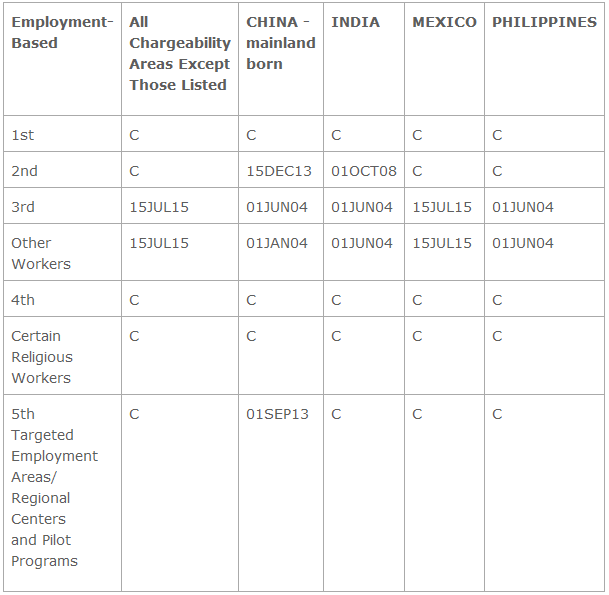 The goal of this post is to provide some basic information to enable you to better understand the U.S. Department of State’s monthly Visa Bulletin with respect an employment-based immigrant visa petition. It is not a substitute for an attorney. If you need additional information and/or are considering retaining an attorney to help you with your immigration issue, please contact us.
The goal of this post is to provide some basic information to enable you to better understand the U.S. Department of State’s monthly Visa Bulletin with respect an employment-based immigrant visa petition. It is not a substitute for an attorney. If you need additional information and/or are considering retaining an attorney to help you with your immigration issue, please contact us.
The table for employment-based permanent resident visas (green cards) is the second table shown on the Visa Bulletin. Here is an example from the August 2015 Visa Bulletin of what the employment-based preferences table looks like:
 To read it, and similar to the family-sponsored preferences table, you need to know the following factors: your birth country, your preference category, and your priority date.
To read it, and similar to the family-sponsored preferences table, you need to know the following factors: your birth country, your preference category, and your priority date.
First find the column for your birth country. If your birth country is not listed, then you fall into the “catch-all” column labeled “All Chargeability Areas Except Those Listed,” i.e., excluding the other listed areas in the table.
Next, find your preference category row. The employment-based preference categories are identified in the text immediately preceding the table:
The employment-based preference categories are more complicated than the family-sponsored preference categories. The first preference category is for “priority” workers. This would include aliens of extraordinary ability and multinational managers. Usually this category does not require a PERM Labor Certification. If your employer filed a PERM for you, you will not be in this category. The second preference category includes PERM cases requiring a master’s or higher degree. It also includes workers qualifying for a national interest waiver. The third preference category is for “skilled workers, professionals, and other workers,” which means workers whose job requires 2 years or more of experience (“skilled workers”) or less than 2 years of experience (“unskilled workers”), and persons whose job requires at least a bachelor’s degree or its equivalent (“professionals”), but less than a master’s degree. Most petitioners with an H-1B visa fit within the second or third preference categories. The fourth preference category is for “special immigrants,” which includes persons who are religious workers, broadcasters, physicians, and other unique circumstances. The fifth preference category is for certain job-creating investors.
Finally, your priority date is the date either your PERM was filed online with the U.S. Department of Labor, or if a PERM was not required, when the I-140 Petition was filed with USCIS. In some cases, if you have a second PERM, your priority date could be the date your first PERM was filed. Your priority date is your place in line, while the date shown on the Visa Bulletin is called the cut-off date. If your priority date is earlier than the cut-off date shown on the Visa Bulletin, then an immigrant visa is available.

Leave a Reply